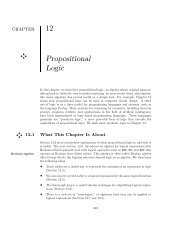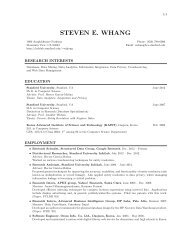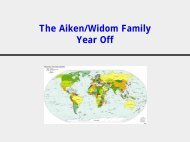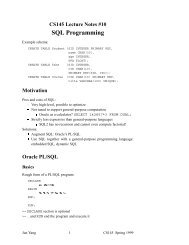Full color PDF file (3 MB) - The Stanford University InfoLab
Full color PDF file (3 MB) - The Stanford University InfoLab
Full color PDF file (3 MB) - The Stanford University InfoLab
You also want an ePaper? Increase the reach of your titles
YUMPU automatically turns print PDFs into web optimized ePapers that Google loves.
Training Data Collection System for a Learning-based<br />
Photographic Aesthetic Quality Inference Engine<br />
ABSTRACT<br />
Razvan Orendovici 1,2 James Z. Wang 2<br />
1 Schreyer Honors College, 2 College of Information Sciences and Technology<br />
<strong>The</strong> Pennsylvania State <strong>University</strong>, <strong>University</strong> Park, Pennsylvania<br />
{ruo3, jwang} @psu.edu<br />
We present a novel data collection system deployed for the<br />
ACQUINE - Aesthetic Quality Inference Engine. <strong>The</strong> goal of<br />
the system is to collect online user opinions, both structured<br />
and unstructured, for training future generation learningbased<br />
aesthetic quality inference engines. <strong>The</strong> development<br />
of the system was based on an analysis of over 60,000 user<br />
comments of photographs. For photos processed and rated<br />
by our engine, all users are invited to provide manual ratings.<br />
<strong>The</strong> users can also choose up to three key photographic<br />
features that the user liked, from a list, or to add features<br />
not in the list. Within a few months that the system<br />
is available for public use, more than 20,000 photos have<br />
received manual ratings and key features for over 1,800<br />
photos have been identified. We expect the data generated<br />
over time will be critical in the study of computational<br />
inferencing of visual aesthetics in photographs. <strong>The</strong> system<br />
is demonstrated at http://acquine.alipr.com.<br />
Categories and Subject Descriptors<br />
H.4.m [Information Systems Applications]: Miscellaneous;<br />
I.5.4 [Pattern Recognition]: Applications<br />
General Terms<br />
Design, Experimentation<br />
Keywords<br />
Aesthetics, User Data Collection, Photography<br />
1. INTRODUCTION<br />
In order to substantially improve the accuracy and usability<br />
of computational photographic aesthetics inferencing systems[1,<br />
2, 3], we need to properly understand what combinations<br />
of features determine photos as aesthetically pleasing.<br />
It is important that computer scientists understand these<br />
various aesthetic qualities and their roles in photo rating<br />
Permission to make digital or hard copies of all or part of this work for<br />
personal or classroom use is granted without fee provided that copies are<br />
not made or distributed for profit or commercial advantage and that copies<br />
bear this notice and the full citation on the first page. To copy otherwise, to<br />
republish, to post on servers or to redistribute to lists, requires prior specific<br />
permission and/or a fee.<br />
MM’10, October 25–29, 2010, Firenze, Italy.<br />
Copyright 2010 ACM 978-1-60558-933-6/10/10 ...$10.00.<br />
so that computational methods can be developed to model<br />
the rating process. Photo peer rating sites (e.g., photo.net)<br />
collect information about visual features in an unstructured<br />
manner, such as using free-text comments. <strong>The</strong> data is less<br />
useful because we cannot accurately parse these comments.<br />
We have very limited knowledge of why we consider<br />
photos to be artistic, interesting, or visually appealing.<br />
We aim at collecting readily-usable data to further this<br />
knowledge. By understanding what qualities of a photo<br />
make it aesthetically pleasing we can correlate those<br />
qualities to lower-level computable visual features. With<br />
a large set of collected data researchers can potentially<br />
improve ACQUINE (Aesthetic Quality Inference Engine) or<br />
other photo rating systems. For instance, the data can help<br />
us to identify a set of photos with good lighting and <strong>color</strong><br />
tones, which can be used to train a classification and rating<br />
system for such photos, based on extractable <strong>color</strong>, texture,<br />
shape, and other features.<br />
<strong>The</strong> design of such a data collection system is non-trivial.<br />
<strong>The</strong>re is a wealth of literature on designing effective humancomputer<br />
interfaces [4]. Typical online users are impatient<br />
that they would not use the system if it is time consuming<br />
and without any rewards. Because the interaction with the<br />
system is entirely anonymous, no reward can be provided.<br />
Hence, the system needs to collect structured information<br />
without taking many mouse clicks for a typical user.<br />
Whereas the system needs to collect structured information<br />
primarily, it is important that unstructured information can<br />
be collected to supplement the structured information.<br />
To achieve these objectives, we first analyzed common<br />
unstructured user comments about visual appearances of<br />
photographs. <strong>The</strong> analysis allowed us to design the system<br />
so that most frequently used visual features can be shown<br />
as clickable choices. Users can add features if the displayed<br />
choices are not sufficient for describing some photographs.<br />
In the next section, we show our analysis which has led to<br />
the current design.<br />
2. THE DESIGN RATIONALE<br />
<strong>The</strong> incredible database of photographs that has been acquired<br />
by flickr.com provides great insight into photographic<br />
patterns, and the way professional and amateur photographers<br />
judge photos. On February 11, 2010, we downloaded<br />
the comments for the top 1,500 most interesting photos on<br />
the site. <strong>The</strong>se are photos that have receiving many views<br />
and comments, and are part of many photo pools. <strong>The</strong><br />
Flickr API system gave us easy access to highly discussed<br />
photos that are appreciated for various qualities by the flickr
Figure 1: Visualization<br />
of phrases used in<br />
the user comments on<br />
1500 most recent ’interesting’<br />
photos gathered<br />
on February 11,<br />
2010, from Flickr. IBM<br />
Many Eyes is used for<br />
plotting. <strong>The</strong> arrows<br />
indicate an “and” association<br />
between the two<br />
terms. Top 50 of the<br />
2225 terms are shown.<br />
(a) Entering data (b) Visualizing community-generated result<br />
Figure 2: <strong>The</strong> data collection process. Screenshots are shown. Copyright of the photo remains with the<br />
original owner(s).<br />
community. We downloaded over 60,000 comments from<br />
these photos and imported them into the IBM Many Eyes<br />
word visualization system. This visualization provides us insights<br />
into the language used to describe photos. In Figure 1,<br />
we provide a screenshot of the visualization 1 . <strong>The</strong> parameters<br />
of this visualization can be slightly altered to provide<br />
different insights into the data. From this visualization we<br />
chose 16 common terms to provide on the ACQUINE system<br />
for users to rate photos with. <strong>The</strong>y are: composition, tones,<br />
3rds-rule, exposure, bokeh, background, softness, mood, detail,<br />
foreground, subject, texture, dof, <strong>color</strong>, sharpness, and<br />
lighting.<br />
3. THE DATA COLLECTION SYSTEM<br />
As aforementioned, the large amount of word possibilities<br />
poses many problems for designing a proper rating system<br />
for a wide user community. Common option choices like<br />
drop down menus, radio buttons, and check boxes would<br />
1 http://manyeyes.alphaworks.ibm.com/manyeyes/<br />
visualizations/common-flickr-comment-phrases<br />
be visually displeasing to users and can detract them from<br />
using the system. We made all the choices clickable links<br />
and had to find a layout that would be more interesting and<br />
pleasing to use than a long list of terms. Due to popularity<br />
of tag-clouds in interactive Web pages, we chose to put the<br />
rating system as a randomly laid out tag cloud. This layout<br />
will prevent biases towards elements placed at the top of the<br />
list, and will be an interesting interface element which users<br />
should easily understand.<br />
Each user is presented with the 16 terms and given the<br />
opportunity to select up to three of them as their favorite<br />
qualities of the photo. We provide interface feedback to<br />
the user by increasing the size of the vote whenever it<br />
is submitted. Once a user submits three votes towards<br />
the current photo we display the rating results from all<br />
the other users. We increase the size of terms linearly to<br />
display their prominence as an enjoyed quality of the photo.<br />
Additionally, we hide this final result from users to prevent<br />
biases from users voting the same way as previous users did.<br />
To make the system easy to use and interactive we use AJAX
Figure 3: Unstructured comments can be added by<br />
a user. Copyright of the photo remains with the<br />
original owner(s).<br />
technologies to submit the votes and not distract users as<br />
the page refreshes after each vote.<br />
We understand that the 16 terms from the Flickr visualization<br />
cannot accurately describe everyone’s impressions<br />
of a photo. For this reason we provide the ability for usrs<br />
to write free-text comments on the photo. A user can click<br />
on “other” to activate the comment box. <strong>The</strong>se text-based<br />
comments can later be analyzed through language processing<br />
routines to provide more understanding of the ratings of<br />
that photo. Figures 2 and 3 demonstrate the interaction of<br />
the rating system.<br />
<strong>The</strong> new data collection system in ACQUINE was<br />
launched in April 2010 for public use. In the last three<br />
months, it has resulted in the submission of over 5,300<br />
visual feature selections (each click is counted once) for<br />
1,800 photos in our ACQUINE database. As data collection<br />
increases we will analyze these with a seven star based<br />
overall aesthetic score as well as with our ACQUINE<br />
generated machine score.<br />
We now show some preliminary analysis of the ratings<br />
as well as an analysis of the ACQUINE system. <strong>The</strong><br />
distribution of the 7-star ratings provided by the users is<br />
similar to that shown in [3]. Many users value their own<br />
photos highly and often rate them with 7 stars. Our photo<br />
discovery system tends to bias the better rated photos<br />
by displaying highly ranked photos on the front page and<br />
ordering results by highly ranked photos. Additionally, we<br />
notice that users tend to spend more time on photos they<br />
find pleasing and are more willing to rate those photos as<br />
opposed to ones less pleasing.<br />
Figure 4 shows the popularity of visual features across<br />
our entire database. Composition, <strong>color</strong>, subject, and<br />
lighting of photos are shown as the most important visual<br />
qualities. It is clear that the development of next generation<br />
aesthetic quality rating systems must focus on composition,<br />
despite the great difficulties in characterizing the quality<br />
Figure 5: User-selected visual features and the<br />
average ACQUINE scores.<br />
Figure 6: A random set of photos with high<br />
ACQUINE scores.<br />
Figure 7: A random set of photos with high userentered<br />
scores in a 7-star rating system.<br />
of composition numerically. In Figure 5, we show the<br />
relationship between user-selected visual features and the<br />
average ACQUINE scores of images. Photos with good<br />
textures or following the rule of thirds have obtained
Figure 8: Example photos and the key visual<br />
features identified by the user.<br />
higher ACQUINE scores, while sharpness, composition, the<br />
separation of foreground and background, and mood appear<br />
to be less important to ACQUINE.<br />
Figures 6 and 7 show random sets of highly rated photos<br />
by ACQUINE and by users, respectively. Figure 8 shows 16<br />
example photos and their key visual features identified by<br />
the users of the system.<br />
Figure 4: Aesthetically important visual qualities.<br />
4. CONCLUSIONS AND FUTURE WORK<br />
Rating of visual aesthetics is a complex topic that provides<br />
challenges for any computational approach. Currently<br />
computer scientists have very limited understanding of<br />
aesthetic qualities and insufficient data to process them<br />
statistically. To address this, we developed a system that<br />
aims at collecting structured and unstructured data about<br />
the aesthetic qualities of photos. <strong>The</strong> data collected over<br />
time will be analyzed and used for developing and training<br />
next-generation systems.<br />
We will collect data from the Website as we work on<br />
implementing more of these ideas to analyze textures,<br />
sharpness, softness, focus and composition of photos. We<br />
will add more functions and further improve the usability of<br />
the data collection system to better suit the research needs.<br />
5. ACKNOWLEDGMENTS<br />
<strong>The</strong> research is supported in part by the US National<br />
Science Foundation under Grant Nos. 0347148 and 0202007.<br />
We thank Ritendra Datta, Dhiraj Joshi, and Jia Li for<br />
valuable discussions and contributions to the ACQUINE<br />
project in its early stage. John Schleicher participated in<br />
the project. We collected research data from Flickr and<br />
Photo.net.<br />
6. REFERENCES<br />
[1] R. Datta, D. Joshi, J. Li, and J. Z. Wang, “Studying<br />
Aesthetics in Photographic Images Using a<br />
Computational Approach,” Proc. of the European<br />
Conference on Computer Vision, Part III, pp. 288-301,<br />
Graz, Austria, May 2006.<br />
[2] R. Datta, J. Li, and J. Z. Wang, “Algorithmic<br />
Inferencing of Aesthetics and Emotion in Natural<br />
Images: An Exposition,” Proc. of the IEEE<br />
International Conference on Image Processing (ICIP),<br />
pp. 105-108, San Diego, California, IEEE, October<br />
2008.<br />
[3] R. Datta and J. Z. Wang, “ACQUINE: Aesthetic<br />
Quality Inference Engine - Real-time Automatic Rating<br />
of Photo Aesthetics,” Proceedings of the ACM<br />
International Conference on Multimedia Information<br />
Retrieval, pp. 421-424, Philadelphia, Pennsylvania,<br />
ACM, March 2010.<br />
[4] A. Dix, J. E. Finlay, G. D. Abowd, and R. Beale,<br />
Human-Computer Interaction, 3rd Edition, Prentice<br />
Hall, 2003.








